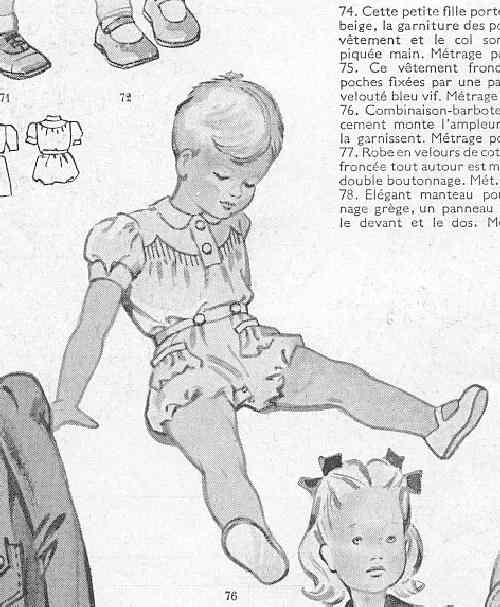
French Sewing Patterns: Romper Suit -- October 1941

Figure 1.--"Modes et travaux" in its October 1941 issue offered a pattern for this romper suit. The pattern was for a 3-year old boy. Note the puffed sleaves and front and back smocking as well as the two pockets on the romper bottoms. Click on the image to see a coat that might have been worn with this romper suit.
|
Modes et travaux in its October 1941 issue offered patterns for several outfits and coats for younger boys and girls. The age for each garment is not specified, but they appear to be for children 3-6 years of age.
Modes et travaux
Modes et travaux was perhaps the most important French sewing magazine in the 1940s. During the German occupation after 1941, clothing became increasingly difficult to obtain. Thus sewing your own or your family's clothing became increasingly important. The title reads, "de jolis ensembles pour nos petits". That would translate as "fun outfits for our little ones". The author then goes on to describe nine different garments or outfits. The romper suit for a little boy described here is one of those outfits. The inference is that the coats shown would have been worn with the coats on cold days.
Fancy Outfits
Modes et travaux in its October 1941 issue offered pattern for two styles of outfits for little boys. One was the romper suit seen here. The other was a fancy button-on outfit. There was also a coat. There were also several dresses and coats for little girls.
Ad Copy
The ad copy for the fancy outfit shown here reads, "76: Combinaison-barboteuse en flanelle bleue, un empiècement monte l'ampleur reprise à nervures. Des poches la garnissent. Métrage pour 3 ans: 1 mètre en 1 mètre." That would translate as, "Blue flannel Combination-rompers, a yoke is shown the entire width (back and front) with the smocking. Pockets finishing on the rompers bottoms. Measurements for a 3 year-old: 1 meter in 1 meter.
Construction
HBC is not precisely sure about the construction of this garment. A French reader tells us that "combinaison barboteuse" refers to a one-piece romper. This can not be destinguished from the illustrayion. We are unsure what the two front buttons are for. We also note that the top part os front buttoning. The standard "barboteuse" was back buttoning and had waste draw strings that tied in a bow at the back. This outfit does not have these draw strings. Our French expert who provided us the scans of many old catalogs and sewing magazines tells us, "I am sure this romper is a one piece garment. Many patterns used traditional garments as a modeled and then styilized them to make them more chic. This is what had with this romper outfit. Thus rompers did appear with out a bow tieing in the back and with an ordinary waist. HBC is correct though that the most common romper outfits for 4-year old boys were the traditional ones that buttoned in back and had waist bands that tied in the back. It should also be remembered that the illustrations sometimes were not always an precise depiction of the pattern offered."
Terminology
A French reader has provided us some details on the terms used in connection with romper outfits. Different publications sometimes used the terms differently. Occassionally Modes et travaux call the one piece-romper "combinaison barboteuse" to refer to the traditional French romper but this term was not commonly used by people which prefered to simply say "barboteuse" for one piece rompers and "ensemble barboteuse" for 2 pieces rompers. (For this reason we are not including "combinaison barboteuse" in our French glossary.) Other terms include "barboteuse bain de soleil" for the summer sun-suit type romper and "barboteuse à bavette" for rompers with bib fronts. There were several other specialized terms for the different kinds of rompers.
"Empiècement" deals with the top of a garment. It is the usually decorative work just under the yoke of smocks and rompers where the fabric is gathered or smock. In fact the modern work "smock" in English is derived from this smocking work. This smocking or gathers are little pleats commonly used for the typical French rompers and smocks as well as in Dutch and Belgian rompers. Mothers according to how much time she had could also do the gathers into fancy smocking or use embroidery with the smocking.
World War II
A French reader notes that Modes et travaux in its issues during World War II used a number of strange or outdated words. "Combinaison barboteuse" was, for example, a term very little used . He tells us, "I think here is the only time I saw the term, perhaps itvwas used in the 1920s." "Pardessus" was another term which appeared in the magazine, it was an old word for "coat" (often used for a man's caot), but by the 1940s was rarely used.
Of course 1941 was during the War. Much of France including Paris was occupied by the Germans and the rest (Vichy) was subject to their authority. One suspects that the staff of the magazine may have changed. Perhaps some older personnel were hired.
Christopher Wagner

Navigate the Boys' Historical Clothing catalog/magazine pages:
[Return to the Main French mail order 1941 page]
[Main photo/publishing page]
[Store catalogs]
[Fashion magazines]
Navigate the Boys' Historical Clothing Web Site:
[Introduction]
[Activities]
[Bibliographies]
[Biographies]
[Chronology]
[Clothing styles]
[Countries]
[Contributions]
[FAQs]
[French glossary]
[Satellite sites]
[Boys' Clothing Home]
Navigate the Boys' Historical Clothing Web Site:
[Blouse]
[Buster Brown suits]
[Button-on suits]
[Pinafores]
[Capes]
[Pinafores]
[Ring bearers]
[Rompers]
[Ruffled collar]
[Sailor suits]
[Sailor hats]
[Smocks]
[Tunics]
Created: December 5, 2001
Last updated: December 7, 2001



